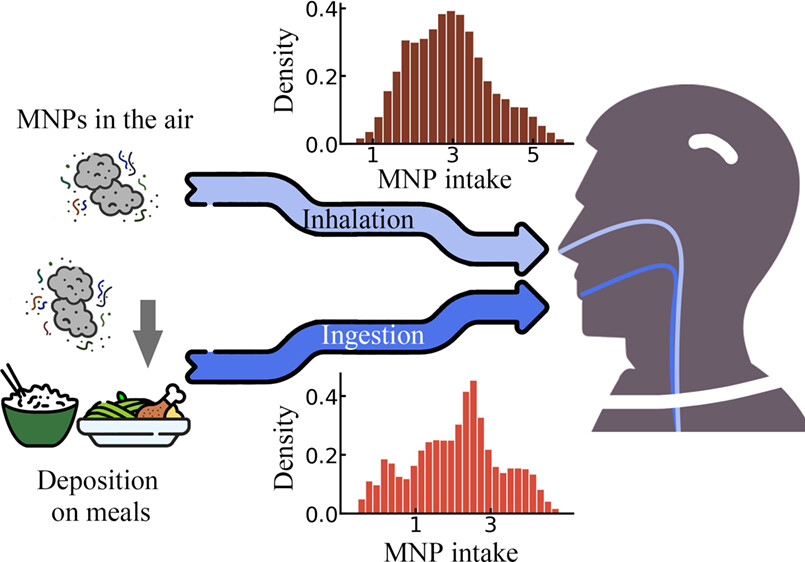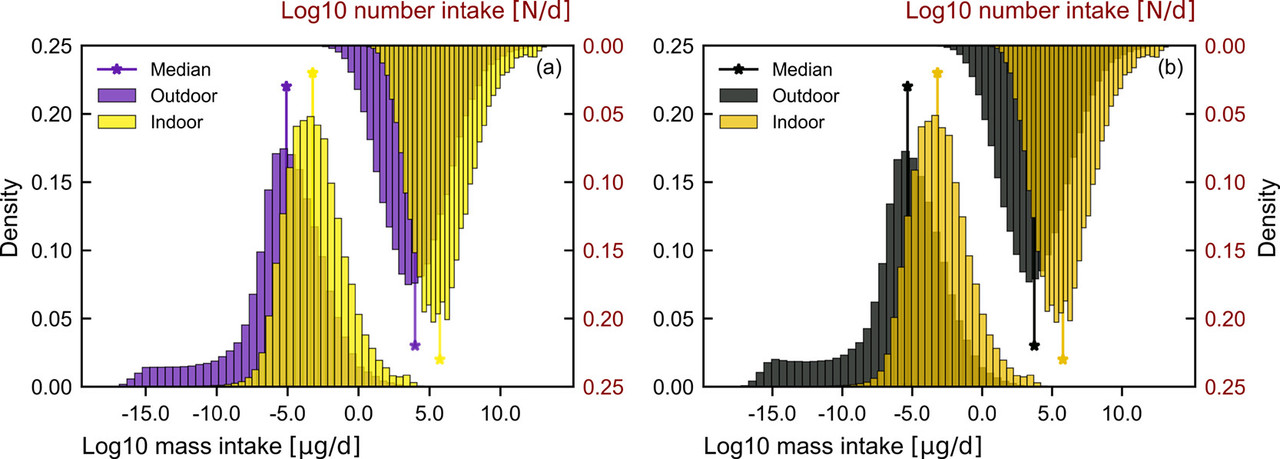Science
Related: About this forumProbabilistic Estimation of Airborne Micro- and Nanoplastic Intake in Humans
The paper to which I'll refer in this post is this one: Probabilistic Estimation of Airborne Micro- and Nanoplastic Intake in Humans Yu Chen, Yuchuan Meng, Guodong Liu, Xiaohua Huang, and Guangming Chai Environmental Science & Technology 2024 58 (21), 9071-9081.
I'm not, unfortunately, going to have much time to discuss this paper, but I thought it worth referring to it as I have increasingly aware of this problem, a relatively recently recognized form of air pollution, adding to the combustion wastes from dangerous fossil fuels and biomass/trash combustion - the latter advertised as so called "renewable energy" - and of course, global heating.
It is worth however, posting a few excerpts from the paper and a few graphics just to raise awareness that it exists.
Several studies have estimated the MP intake from different sources, such as air, water, and food, concluding that airborne MPs (AMPs) contribute significantly to the overall human uptake of MPs. (1,24?27) However, the magnitude, variability, and uncertainty of AMP exposure and intake rates globally remain little known. Previous estimations of human exposure to AMPs were almost in a deterministic manner, irrespective of the uncertainties in the data sets used. Due to the differences in analytical techniques, the reported MP abundances in different studies can vary by several orders of magnitude, resulting in a predicament of incomparability for the current MP research. Additionally, their estimations failed to estimate AMPs from the full MP continuum (1–5000 ?m). (28) Furthermore, single exposure estimates based on average rates may not well represent the distribution of global AMP intake. A previous study presented an efficient probabilistic method to calculate the MP intake for children and adults. (24) However, their estimation was based on a limited data set and did not differentiate between indoor and outdoor air, potentially leading to an underestimation of AMP intake through inhalation...
The paper itself is a meta-analysis based on a literature survey of 649 papers reporting on the concentrations of microplastics and nanoplastics in air, coupled with some stochastic mathematics.
A cartoon from the abstract:

A graphic from the paper:

The caption:

Intake from all routes, deposition on food, breathing is estimated to be on the order of a few tens of thousands of particles a day, at a scale of hundredths of micrograms. The authors note that the associated toxicology is connected with particle size and composition.
One of my critics here, now happily residing on my ignore list, once noted using the cliche - with a good deal of accuracy I might add - that when your favorite tool is a hammer, every problem looks like a nail.
Accordingly, I have attempted to convince my son, a nuclear engineering Ph.D. student, that air based Brayton power cycles should be incorporated into heat flows in nuclear power plants. Over long periods of time this would have the effect of oxidizing this particular form of air pollution, micro and nanoplastics and may offer other benefits, such as direct air carbon capture and the destruction of fluorocarbons and methane and other alkanes, sulfate capture, but raising the necessity for dealing the the potential of generation of nitrogen oxides.
Have a nice afternoon.
Turbineguy
(38,381 posts)airplane routes could be modified for this purpose as well.
" air based Brayton power cycles should be incorporated into heat flows in nuclear power plants. Over long periods of time this would have the effect of oxidizing this particular form of air pollution, micro and nanoplastics and may offer other benefits, such as direct air carbon capture and the destruction of fluorocarbons and methane and other alkanes, sulfate capture, but raising the necessity for dealing the the potential of generation of nitrogen oxides."
Easterncedar
(3,527 posts)Even far off potential solutions give me a welcome whiff of hope